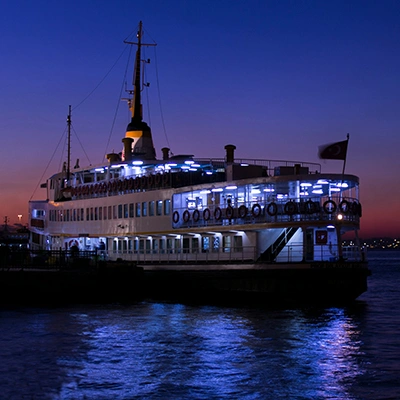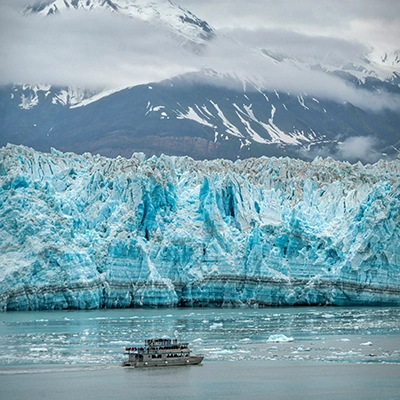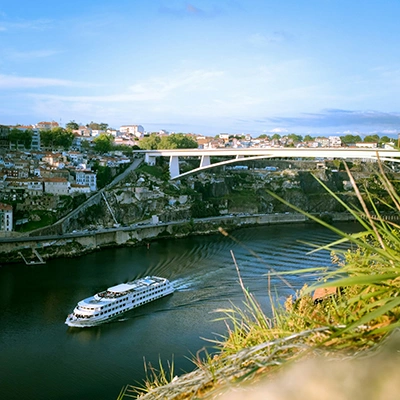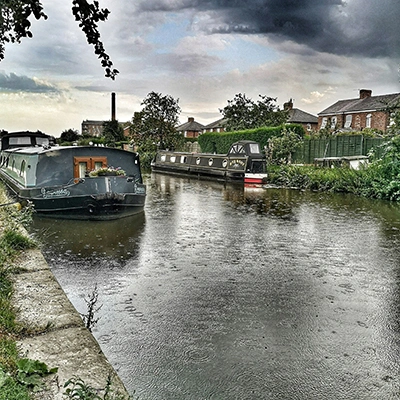Regular cruisers know how it works. You make your way to Miami or Barcelona and join the throngs of other travelers aboard a massive ocean liner. Over the course of the next few days or weeks, you move from one port to the next, see the tourist hotspots, indulge in decadent meals, maybe play a game of pickleball on deck.
But what if you want more than the average cruise? If you’re looking for something different, these lesser-known types of cruises will give you a fresh outlook on sailing.
Repositioning Cruises
Perhaps the closest on our list to a typical ocean cruise is the repositioning cruise. If you have the extra time and think the best thing about sailing is the days at sea, this could be for you.
What is a repositioning cruise?

This usually happens at the end or beginning of the season as the cruise line moves the ship toward warmer weather. The sailings are longer — usually two weeks or more — and they’re one-way journeys.
A repositioning cruise usually follows a transatlantic route. Don’t expect a typical itinerary, though. Most of your days will be filled with on-ship activities rather than exploring at ports. This is a big positive for some cruisers; it gives you more time to relax, unwind, and spend quality time with family.
While the cruise line will do everything it can to make your trip incredible, the company's ultimate goal really is to get the ship from Point A to Point B.
Transatlantic repositioning cruise
These routes are typically between Europe and the U.S., following either a northern route or southern route. They vary by cruise line and where that company’s ports of embarkation are.
Common transatlantic repositioning cruises go from Florida to Europe (Portugal, Spain, or France, for example) and vice versa. The usual ports of call on these routes include Bermuda and other points in the Caribbean.
Alternatively, you could find a repositioning cruise between Europe and New York. These sometimes make stops at less common ports farther north like Greenland.
Transpacific repositioning cruise
You might need to block off a month on your calendar for a transpacific repositioning cruise, but you won’t regret the time spent on board. One common route takes you between Australia and Hawaii, visiting ports in New Zealand or Polynesian islands like Tahiti along the way.
You’ll often find transpacific repositioning cruises between Japan and the U.S. West Coast as well.
U.S. West Coast repositioning cruise
Less common although possibly more accessible to travelers who don’t have several weeks to dedicate to a single vacation is an Alaskan repositioning cruise.
These tend to be just a few days with an itinerary that takes you between Southern California and Vancouver (heading north toward Alaska in the spring and south toward warmer weather in the fall).
Expedition Cruises
An expedition cruise is more about the destination and less about just cruising. If you’re someone who thinks lounging on the deck and stuffing yourself at the buffet is a boring way to spend a vacation, you might consider an expedition cruise.
Ships are smaller and outfitted to take passengers to more remote places. You’ll have highly trained guides at your disposal, helping you on kayaking excursions or hiking through mountains at a port of call.
Some consider this type of cruise the answer for those who want to sail in luxury but with more adventure.
Alaska expedition cruises

Itineraries for the Inside Passage might take you to see glaciers and whales, through hidden coves, and deep into national park land.
Other routes might keep you more along the coast where you have more towns to explore. These often focus on Native Alaskan culture and heritage, while also giving you a chance to meander through fjords full of wildlife.
Yet another option is a one-way cruise starting in Alaska and ending in Japan. Your itinerary is filled with natural wonders and national parks on either end, and in between are several days at sea where you can take advantage of activities like naturalist talks and photography workshops, or relax on your own.
Because you’re so far north for these trips, the season for an expedition cruise in Alaska is somewhat short. Aim to go in the spring or early summer. The weather is warmest — and sunniest — in July and August. This is peak travel season for Alaska, but your smaller expedition ship might be able to get you away from the worst of the crowds.
The biggest player in expedition cruises, especially in this region, is Linblad Expeditions. The cruise line has combined with National Geographic to offer memorable adventures off the main tourist path.
Antarctica expedition cruises
Antarctica is another popular expedition cruise destination for many of the same reasons they’re popular in Alaska. You can get in amongst glaciers and over terrain that’s not easily accessible over land.
Antarctic expedition cruises might be combined with other locales like Patagonia or the Falkland Islands. Not surprisingly, these routes are all about frozen landscapes and wildlife you’re unlikely to find anywhere else. Think penguins, whales, and seals in their natural habitat.
It’s important (at least for us) to note that many travel insurance plans do not cover you in Antarctica. So while this is an exceptional destination, it does come with higher risk than many other locations. Consider that in your plans.
Pacific islands expedition cruises
Not all expedition cruises are cold. One on our bucket list takes you to the Pacific islands like French Polynesia, Samoa, and Fiji.
These routes typically include multiple island groups. You’ll snorkel, visit UNESCO World Heritage Sites that protect the cultural heritage of the islands, and enjoy all things marine.
European River Cruises

Many companies have updated their offerings, adding themed cruises and land excursions to appeal to younger passengers as well as combining itineraries to create longer journeys that allow travelers to see more on a single sailing.
With these updated offerings, you have more opportunity to experience Europe on a low-key cruise, letting others handle the travel logistics while you enjoy a home away from home aboard a ship.
River cruise ships are smaller than ocean liners, often accommodating 100 to 300 passengers. They tend to be about 400 feet long, give or take a few depending on the cruise line, which is about the length of an American football field. They’re also much narrower.
The compactness of a river cruise ship allows it to navigate smaller waterways and make its way through locks that ocean liners can’t even begin to attempt.
Whereas amenities such as a spa or fitness facility are a given on ocean liners, you can’t make the same assumption on a river cruise ship. Your river cruise ship will have restaurants, but perhaps only one or two compared to multiple on large ships.
While there are slightly fewer options, the tradeoff is that you can visit different locales and do it amongst fewer crowds.
Viking River Cruises

One of pros of taking a river cruise with Viking is its many itineraries throughout Europe. In addition to popular French routes on the Seine or Central European sailings on the Danube, you’ll also find itineraries that include Switzerland, Portugal, and more.
If you want to combine your river cruise with an ocean cruise, you can do that, too. This incredible two-week trip takes you from Switzerland and north through Germany and the Netherlands until you reach the North Sea. From there, you continue on your northward route toward Scandinavia.
Viking is hardly the only river cruise line out there. It does set a high standard for other companies, but you’ll also pay for that high standard. If you’re traveling on a budget, keep an eye out for special deals, as that’s probably your best bet for saving money on a Viking River Cruise.
Seine River cruises
If you’re less particular about the cruise line and want a classic river cruise destination, look no farther than the Seine. Running through Paris, a cruise on the Seine River shows off some of the highlights of the City of Light.
This is one of the more crowded itineraries for a river cruise, but only because it’s popular. And for good reason. You get all the benefits of a river cruise with excursions to the Louvre, Eiffel Tower, Champs-Élysées, and more iconic sites.
If you’re looking for a river cruise in France but want to get away from the busy capital, try Burgundy and Provence (especially if you love wine) or one of many Rhine river cruises.
Danube River cruises
At 2,000 miles, the Danube is one of the longest rivers in Europe, so cruises along this waterway take many forms. Some of the best Danube river cruises include Budapest. The Hungarian city is steeped in history that’s on display through its architecture, food, and museums.
Also on many Danube itineraries are the Black Forest in Germany, where the river begins, Vienna, and Prague. In between visiting these metropolitan gems, you can take in plenty of natural scenic beauty along the riverbanks.
U.S. River Cruises
With our love of driving and the ease of flying, Americans often forget that rivers used to be a main mode of transportation. Our massive network of rivers gives us a wide range of cruising options and a different perspective from which to see the U.S.
What is the best river cruise in the USA?
U.S. cruise lines know how to do a themed trip, and some of the best river cruises in the USA cater to specific interests. You’ll find bourbon cruises on the Mississippi River, music cruises to Nashville, culinary cruises around New Orleans, and wine cruises in Napa Valley.
Other lines focus on the character of the location. Cruises in Martha’s Vineyard and the Northeast showcase postcard-worthy scenes of lighthouses and plates full of lobster. Itineraries throughout the Midwest highlight the region’s history where early settlers explored.
The best cruise is one that piques your own interests.
Mississippi River cruises
The Mississippi River is the second-longest in the U.S. (it’s true; the Missouri River is a teensy bit longer), but it’s also the most famous.
Most Mississippi River cruises explore only a portion of the river, either the upper or the lower. Upper Mississippi itineraries typically run between Minneapolis, Minnesota, and Memphis, Tennessee. You’ll find several departures in St. Louis, too.
Stops on these routes include historic towns filled with legends of pioneer days. Don’t be surprised if there’s a port of call at Hannibal, Missouri, too. It’s the hometown of Mark Twain after all.
Lower Mississippi river cruise routes typically run between Memphis and New Orleans. These really double down on Southern culture. Itineraries tend to focus on food — po'boys, soul food, beignets — Black history, Civil War battlefields, and music.
Hudson River cruises
Combine your dreams of cruising with leaf peeping by taking a cruise on the Hudson River in the fall. It’s typically an out-and-back route, sailing between New York City or New Jersey and upstate New York.
You’ll travel through the Hudson River Valley by West Point, home of the U.S. Military Academy; Hyde Park, once the residence of Franklin D. Roosevelt; and further north toward Albany. It’s an area not only renowned for its natural beauty, but also as the seat of countless industrialists, politicians, and others on the list of who’s who for shaping our nation.
For a fall foliage cruise, book your trip for September or October (although some cruise lines run as late as November). Just remember that it’s hard to predict exactly when the leaves will be at their brightest. Even if you miss peak season, you’re sure to enjoy a beautiful journey.
Barge Cruises

Don’t let this fool you into thinking they’re dull, though. Because of the barge’s slower speeds, you have more opportunity to hop on and hop off. While your barge is going through one lock — and depending on where you’re cruising, there could be a lot of them — you can go on shore, walk around, and even ride a bike to the next lock where you’ll meet up with your vessel again.
Whereas a typical ocean liner is usually described as a “floating city,” barge cruises are more of a “floating hotel.” They’re smaller, allowing them to fit through narrow waterways. That means there are also fewer people aboard, sometimes as few as four passengers and rarely more than 30. All of this might appeal to you if you aren’t a fan of crowds, either on the ship or on shore.
Luxury barging
You’ll still get fine dining, including buffets, which is always a perk of taking a cruise. One of the upsides of a luxury barge compared to a more traditional river cruise, however, is that more meals are taken on shore. This gives you the opportunity to sample local cuisine at the source.
What you won’t find are some of the entertainment and amenities common on large ships. Some barges might have laundry service, but that tends to be the exception rather than the rule. You also won’t find water parks, bowling alleys, and large theaters.
Rather than extravagant floor shows, you’re more likely to be entertained by intimate gatherings about the local culture, wine and cheese tastings from local businesses, and daytime excursions to remote villages.
You’ll have a dedicated crew on board with cruise directors and cabin stewards. You might even find that there are as many crew members as there are passengers, giving you personalized service.
Who should take a barge cruise?
Because of their small size, barge cruises are a unique way to travel with a family or small group and make it feel like a private or charter cruise. Imagine booking a six-passenger luxury barge cruise with a few friends for the week. Or maybe you’re part of a couples group looking for an easy, relaxing getaway together.
Barge cruises may also be ideal for someone who doesn’t want to feel trapped by crowds and the overrun ports visited by typical cruises.
Barge cruises in France
Yes, you can take a river cruise on the Seine. Or you can get away from Paris and explore France’s other rivers and canals. Passengers often say a French barge cruise is the perfect way to see the countryside at a leisurely pace.
Barge cruises in France can take you to regions most famous for their scenic countryside. This includes places like Burgundy, the Loire Valley, and Canal du Midi. Or head to the Champagne region or Alsace and Lorraine instead.
Being in the French countryside puts you in a prime location for exploring chateaux, visiting vineyards and sampling local wines, discovering cheeses you’ve never heard of, and cycling along canals where the towpath was carved by livestock during an earlier era.
Barge cruises in Europe
France doesn’t have a monopoly on luxury barging. Scotland has some stunning routes through lochs and mountains. The Netherlands, known for its canals, is another great option.
Although less common, you’ll find some barge cruise itineraries in Italy and Germany as well.
Travel Insurance for Cruises
These types of cruises might be unique, but you still need to protect your trip just like any other vacation. Seven Corners Cruise Insurance covers medical and trip expenses, whether you’re on a repositioning cruise on the Pacific Ocean or drifting along a Dutch canal on a luxury barge.
Our cruise insurance includes protection for trip cancellation, interruption, and delay as well as missed tour or cruise connection benefits. It can also pay your medical expenses if you get sick or hurt during your trip, something your domestic health insurance typically won’t do when you’re abroad.
Get a quick quote for Seven Corners Cruise Insurance or talk to one of our licensed agents about protecting your unique getaway.
Travel Like a Pro with The Wayfinder
Did you enjoy this blog? Get more articles like it before anyone else when you subscribe to our monthly newsletter, The Wayfinder.
Sign me up